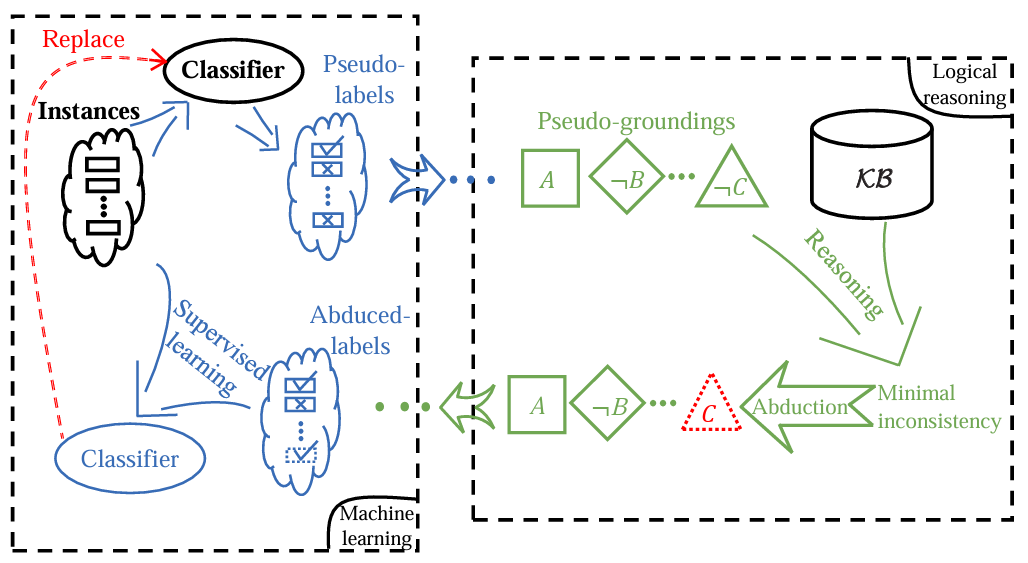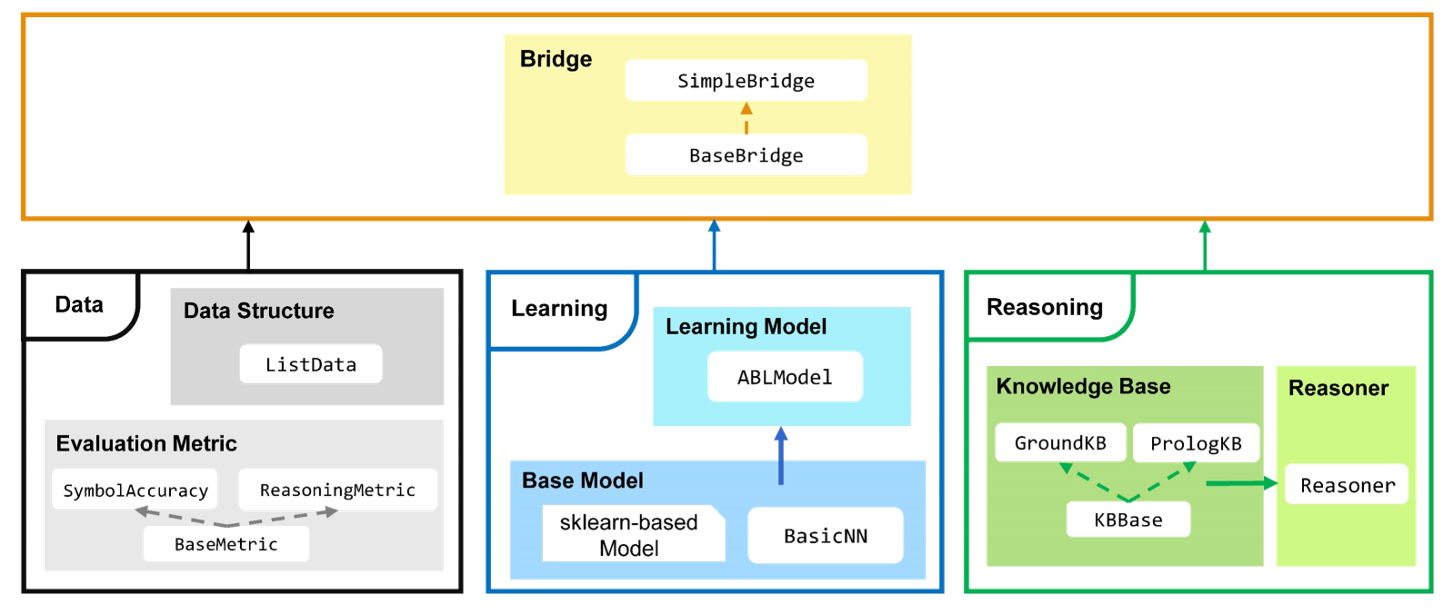Ecosyste.ms: Awesome
An open API service indexing awesome lists of open source software.
https://github.com/abductivelearning/ablkit
An efficient Python toolkit for Abductive Learning (ABL), a novel paradigm that integrates machine learning and logical reasoning in a unified framework.
https://github.com/abductivelearning/ablkit
abductive-learning machine-learning neuro-symbolic neuro-symbolic-learning python pytorch sklearn
Last synced: 6 minutes ago
JSON representation
An efficient Python toolkit for Abductive Learning (ABL), a novel paradigm that integrates machine learning and logical reasoning in a unified framework.
- Host: GitHub
- URL: https://github.com/abductivelearning/ablkit
- Owner: AbductiveLearning
- License: other
- Created: 2022-02-13T02:51:29.000Z (about 3 years ago)
- Default Branch: main
- Last Pushed: 2024-09-12T06:16:54.000Z (5 months ago)
- Last Synced: 2025-02-20T05:13:01.403Z (7 minutes ago)
- Topics: abductive-learning, machine-learning, neuro-symbolic, neuro-symbolic-learning, python, pytorch, sklearn
- Language: Python
- Homepage: https://ablkit.readthedocs.io/
- Size: 9.39 MB
- Stars: 53
- Watchers: 4
- Forks: 3
- Open Issues: 0
-
Metadata Files:
- Readme: README.md
- License: LICENSE
Awesome Lists containing this project
README

[](https://pypi.org/project/ablkit/) [](https://pypi.org/project/ablkit/) [](https://ablkit.readthedocs.io/en/latest/?badge=latest) [](https://github.com/AbductiveLearning/ABLkit/blob/main/LICENSE) [](https://github.com/AbductiveLearning/ABLkit/actions/workflows/lint.yaml) [](https://github.com/psf/black) [](https://github.com/AbductiveLearning/ABLkit/actions/workflows/build-and-test.yaml)
[📘Documentation](https://ablkit.readthedocs.io/en/latest/index.html) | [📄Paper](https://journal.hep.com.cn/fcs/EN/10.1007/s11704-024-40085-7) | [📚Examples](https://github.com/AbductiveLearning/ABLkit/tree/main/examples) | [💬Reporting Issues](https://github.com/AbductiveLearning/ABLkit/issues/new)
# ABLkit: A Toolkit for Abductive Learning
**ABLkit** is an efficient Python toolkit for [**Abductive Learning (ABL)**](https://www.lamda.nju.edu.cn/publication/chap_ABL.pdf). ABL is a novel paradigm that integrates machine learning and logical reasoning in a unified framework. It is suitable for tasks where both data and (logical) domain knowledge are available.

Key Features of ABLkit:
- **High Flexibility**: Compatible with various machine learning modules and logical reasoning components.
- **Easy-to-Use Interface**: Provide data, model, and knowledge, and get started with just a few lines of code.
- **Optimized Performance**: Optimization for high performance and accelerated training speed.
ABLkit encapsulates advanced ABL techniques, providing users with an efficient and convenient toolkit to develop dual-driven ABL systems, which leverage the power of both data and knowledge.

## Installation
### Install from PyPI
The easiest way to install ABLkit is using ``pip``:
```bash
pip install ablkit
```
### Install from Source
Alternatively, to install from source code, sequentially run following commands in your terminal/command line.
```bash
git clone https://github.com/AbductiveLearning/ABLkit.git
cd ABLkit
pip install -v -e .
```
### (Optional) Install SWI-Prolog
If the use of a [Prolog-based knowledge base](https://ablkit.readthedocs.io/en/latest/Intro/Reasoning.html#prolog) is necessary, please also install [SWI-Prolog](https://www.swi-prolog.org/):
For Linux users:
```bash
sudo apt-get install swi-prolog
```
For Windows and Mac users, please refer to the [SWI-Prolog Install Guide](https://github.com/yuce/pyswip/blob/master/INSTALL.md).
## Quick Start
We use the MNIST Addition task as a quick start example. In this task, pairs of MNIST handwritten images and their sums are given, alongwith a domain knowledge base which contains information on how to perform addition operations. Our objective is to input a pair of handwritten images and accurately determine their sum.
Working with Data
ABLkit requires data in the format of `(X, gt_pseudo_label, Y)` where `X` is a list of input examples containing instances, `gt_pseudo_label` is the ground-truth label of each example in `X` and `Y` is the ground-truth reasoning result of each example in `X`. Note that `gt_pseudo_label` is only used to evaluate the machine learning model's performance but not to train it.
In the MNIST Addition task, the data loading looks like:
```python
# The 'datasets' module below is located in 'examples/mnist_add/'
from datasets import get_dataset
# train_data and test_data are tuples in the format of (X, gt_pseudo_label, Y)
train_data = get_dataset(train=True)
test_data = get_dataset(train=False)
```
Building the Learning Part
Learning part is constructed by first defining a base model for machine learning. ABLkit offers considerable flexibility, supporting any base model that conforms to the scikit-learn style (which requires the implementation of `fit` and `predict` methods), or a PyTorch-based neural network (which has defined the architecture and implemented `forward` method). In this example, we build a simple LeNet5 network as the base model.
```python
# The 'models' module below is located in 'examples/mnist_add/'
from models.nn import LeNet5
cls = LeNet5(num_classes=10)
```
To facilitate uniform processing, ABLkit provides the `BasicNN` class to convert a PyTorch-based neural network into a format compatible with scikit-learn models. To construct a `BasicNN` instance, aside from the network itself, we also need to define a loss function, an optimizer, and the computing device.
```python
import torch
from ablkit.learning import BasicNN
loss_fn = torch.nn.CrossEntropyLoss()
optimizer = torch.optim.RMSprop(cls.parameters(), lr=0.001, alpha=0.9)
device = torch.device("cuda" if torch.cuda.is_available() else "cpu")
base_model = BasicNN(model=cls, loss_fn=loss_fn, optimizer=optimizer, device=device)
```
The base model built above is trained to make predictions on instance-level data (e.g., a single image), while ABL deals with example-level data. To bridge this gap, we wrap the `base_model` into an instance of `ABLModel`. This class serves as a unified wrapper for base models, facilitating the learning part to train, test, and predict on example-level data, (e.g., images that comprise an equation).
```python
from ablkit.learning import ABLModel
model = ABLModel(base_model)
```
Building the Reasoning Part
To build the reasoning part, we first define a knowledge base by creating a subclass of `KBBase`. In the subclass, we initialize the `pseudo_label_list` parameter and override the `logic_forward` method, which specifies how to perform (deductive) reasoning that processes pseudo-labels of an example to the corresponding reasoning result. Specifically, for the MNIST Addition task, this `logic_forward` method is tailored to execute the sum operation.
```python
from ablkit.reasoning import KBBase
class AddKB(KBBase):
def __init__(self, pseudo_label_list=list(range(10))):
super().__init__(pseudo_label_list)
def logic_forward(self, nums):
return sum(nums)
kb = AddKB()
```
Next, we create a reasoner by instantiating the class `Reasoner`, passing the knowledge base as a parameter. Due to the indeterminism of abductive reasoning, there could be multiple candidate pseudo-labels compatible to the knowledge base. In such scenarios, the reasoner can minimize inconsistency and return the pseudo-label with the highest consistency.
```python
from ablkit.reasoning import Reasoner
reasoner = Reasoner(kb)
```
Building Evaluation Metrics
ABLkit provides two basic metrics, namely `SymbolAccuracy` and `ReasoningMetric`, which are used to evaluate the accuracy of the machine learning model's predictions and the accuracy of the `logic_forward` results, respectively.
```python
from ablkit.data.evaluation import ReasoningMetric, SymbolAccuracy
metric_list = [SymbolAccuracy(), ReasoningMetric(kb=kb)]
```
Bridging Learning and Reasoning
Now, we use `SimpleBridge` to combine learning and reasoning in a unified ABL framework.
```python
from ablkit.bridge import SimpleBridge
bridge = SimpleBridge(model, reasoner, metric_list)
```
Finally, we proceed with training and testing.
```python
bridge.train(train_data, loops=1, segment_size=0.01)
bridge.test(test_data)
```
To explore detailed tutorials and information, please refer to: [Documentation on Read the Docs](https://ablkit.readthedocs.io/en/latest/index.html).
## Examples
We provide several examples in `examples/`. Each example is stored in a separate folder containing a README file.
+ [MNIST Addition](https://github.com/AbductiveLearning/ABLkit/tree/main/examples/mnist_add)
+ [Handwritten Formula (HWF)](https://github.com/AbductiveLearning/ABLkit/tree/main/examples/hwf)
+ [Handwritten Equation Decipherment](https://github.com/AbductiveLearning/ABLkit/tree/main/examples/hed)
+ [Zoo](https://github.com/AbductiveLearning/ABLkit/tree/main/examples/zoo)
## References
For more information about ABL, please refer to: [Zhou, 2019](http://scis.scichina.com/en/2019/076101.pdf) and [Zhou and Huang, 2022](https://www.lamda.nju.edu.cn/publication/chap_ABL.pdf).
```
@article{zhou2019abductive,
title = {Abductive learning: towards bridging machine learning and logical reasoning},
author = {Zhou, Zhi-Hua},
journal = {Science China Information Sciences},
volume = {62},
number = {7},
pages = {76101},
year = {2019}
}
@incollection{zhou2022abductive,
title = {Abductive Learning},
author = {Zhou, Zhi-Hua and Huang, Yu-Xuan},
booktitle = {Neuro-Symbolic Artificial Intelligence: The State of the Art},
editor = {Pascal Hitzler and Md. Kamruzzaman Sarker},
publisher = {{IOS} Press},
pages = {353--369},
address = {Amsterdam},
year = {2022}
}
```
## Citation
To cite ABLkit, please cite the following paper: [Huang et al., 2024](https://journal.hep.com.cn/fcs/EN/10.1007/s11704-024-40085-7).
```
@article{ABLkit2024,
author = {Huang, Yu-Xuan and Hu, Wen-Chao and Gao, En-Hao and Jiang, Yuan},
title = {ABLkit: a Python toolkit for abductive learning},
journal = {Frontiers of Computer Science},
volume = {18},
number = {6},
pages = {186354},
year = {2024}
}
```